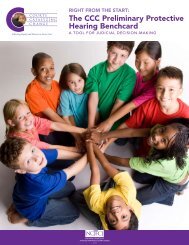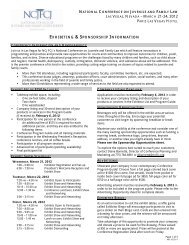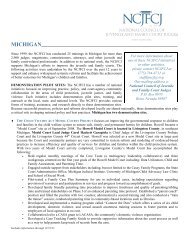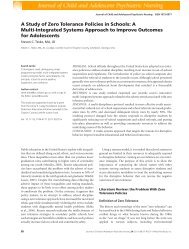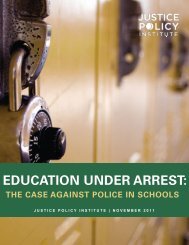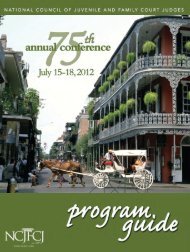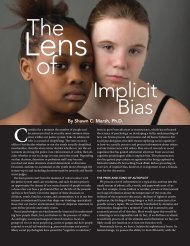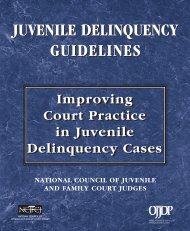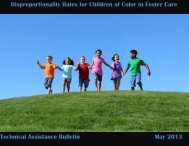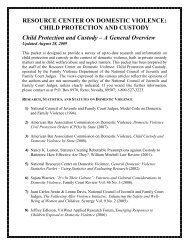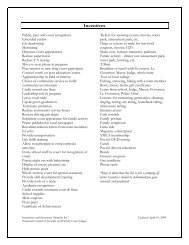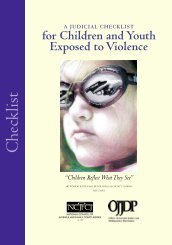dowNload - National Council of Juvenile and Family Court Judges
dowNload - National Council of Juvenile and Family Court Judges
dowNload - National Council of Juvenile and Family Court Judges
You also want an ePaper? Increase the reach of your titles
YUMPU automatically turns print PDFs into web optimized ePapers that Google loves.
The <strong>National</strong> Academy <strong>of</strong> Sciences<br />
Reforming <strong>Juvenile</strong> Justice:<br />
A Developmental Approach<br />
By Melissa Sickmund, Ph.D.<br />
The <strong>National</strong> Academy <strong>of</strong> Sciences recently released Reforming<br />
<strong>Juvenile</strong> Justice: A Developmental Approach. The preface<br />
begins —<br />
“Recent findings from research on adolescent development,<br />
<strong>and</strong> particularly increasing knowledge about the adolescent<br />
brain, have led to deep <strong>and</strong> growing concerns about the<br />
treatment <strong>of</strong> juveniles in the nation’s justice system. There is a<br />
fundamental disconnect between what is now known about<br />
the characteristic features <strong>of</strong> adolescents <strong>and</strong> the apparent<br />
assumptions <strong>of</strong> that system. One reflection <strong>of</strong> that disconnect<br />
is a recent series <strong>of</strong> decisions from the United States Supreme<br />
<strong>Court</strong> forbidding the most severe penalties for adolescent<br />
<strong>of</strong>fenders, especially the death penalty. There have also been<br />
a wide range <strong>of</strong> reforms in the administration <strong>of</strong> juvenile justice<br />
over the past 15 years, some <strong>of</strong> which reflect the emerging<br />
knowledge about adolescents <strong>and</strong> some <strong>of</strong> which do not.”<br />
The Committee on Assessing <strong>Juvenile</strong> Justice Reform (whose members<br />
included NCJFCJ past president Judge Ernestine Gray) was asked<br />
to review reforms over the past 15 years in light <strong>of</strong> research knowledge<br />
about adolescent development. Their premise was that the juvenile<br />
justice system should be informed by what is known about adolescent<br />
development, <strong>and</strong> if it were, better outcomes would result. If not, “the<br />
outcome is likely to be negative interactions between youth <strong>and</strong> justice<br />
system <strong>of</strong>ficials, increased disrespect for the law <strong>and</strong> legal authority,<br />
<strong>and</strong> the reinforcement <strong>of</strong> a deviant identity <strong>and</strong> social disaffection.”<br />
The report makes the case that a harsh system <strong>of</strong> sanctioning juvenile<br />
<strong>of</strong>fenders can make things worse, but a system based on science <strong>and</strong><br />
evidence about what works can make a positive difference in the lives<br />
<strong>of</strong> youth who most need structure <strong>and</strong> services that the juvenile justice<br />
system can provide.<br />
The report summarizes research on adolescence, pointing out three<br />
important ways adolescents differ from adults:<br />
• They are less able to regulate their behavior in emotionally charged<br />
situations.<br />
• They are more sensitive to external influences such as peer pressure<br />
<strong>and</strong> immediate rewards.<br />
• They show less ability to make judgments <strong>and</strong> make decisions that<br />
require future orientation.<br />
The report discusses the existing juvenile justice system <strong>and</strong> identifies<br />
three ways that residential placement interferes with adolescents’ healthy<br />
development:<br />
• Disrupting involvement <strong>of</strong> a caring/concerned parent or parent figure<br />
with the adolescent.<br />
• Limiting adolescents’ opportunities to associate with positive peers.<br />
• Removing adolescents from activities that require autonomous decision<br />
making <strong>and</strong> critical thinking, like school <strong>and</strong> extracurricular activities.<br />
The committee argues for a developmental approach to juvenile<br />
justice that holds youth accountable, prevents subsequent <strong>of</strong>fending,<br />
<strong>and</strong> treats youth fairly. They made several recommendations for state<br />
<strong>and</strong> tribal governments including:<br />
• They should establish bipartisan multi-stakeholder task forces or<br />
commissions, under the auspices <strong>of</strong> the governor, the legislature, or the<br />
highest state court, to undertake a thorough <strong>and</strong> transparent assessment<br />
<strong>of</strong> their juvenile justice systems.<br />
• They should align their laws, policies, <strong>and</strong> practices with evolving<br />
knowledge about adolescent development <strong>and</strong> evidence-based programs.<br />
• They should intensify efforts to identify <strong>and</strong> eliminate policies that<br />
tend to disadvantage minorities, to publicly report on the scope <strong>of</strong> the<br />
problem, <strong>and</strong> to evaluate programs aimed at reducing disparities.<br />
Recommendations aimed toward federal policymakers include:<br />
• Restore the Office <strong>of</strong> <strong>Juvenile</strong> Justice <strong>and</strong> Delinquency Prevention’s<br />
(OJJDP) capacity to carry out its core mission through reauthorization,<br />
appropriations, <strong>and</strong> funding flexibility.<br />
• Define status <strong>of</strong>fenders to include <strong>of</strong>fenses such as possession <strong>of</strong> alcohol<br />
or tobacco that apply only to youth younger than 21.<br />
• Remove all exceptions to the detention <strong>of</strong> youth who commit <strong>of</strong>fenses<br />
that would not be punishable by confinement if committed by an adult.<br />
Youth should not be detained for truancy or running away.<br />
• Modify the definition <strong>of</strong> “adult inmate” to give states flexibility to keep<br />
youth in juvenile facilities until they reach the age <strong>of</strong> extended juvenile<br />
court jurisdiction.<br />
• Exp<strong>and</strong> the <strong>Juvenile</strong> Justice <strong>and</strong> Delinquency Prevention Act protections<br />
to all youth under pretrial detention, whether they are charged in<br />
juvenile or criminal court.<br />
Recommendations were also made regarding OJJDP <strong>and</strong> other<br />
federal research agencies <strong>and</strong> their support <strong>of</strong> research on adolescent<br />
development. In addition, a recommendation was made that federal<br />
<strong>and</strong> private statistical agencies develop a data improvement program<br />
on juvenile <strong>of</strong>fending <strong>and</strong> juvenile justice system processing that<br />
provides greater insight into state <strong>and</strong> local variations.<br />
The report cites several NCJFCJ publications <strong>and</strong> publications<br />
authored by the <strong>National</strong> Center for <strong>Juvenile</strong> Justice (NCJJ) staff.<br />
NCJJ will continue to help OJJDP make juvenile justice statistical<br />
information available to the public through the Statistical Briefing<br />
Book (http://www.ojjdp.gov/ojstatbb/default.asp) <strong>and</strong> various publications<br />
<strong>and</strong> hopes to be able to continue to work with OJJDP to improve<br />
juvenile justice data throughout the country. If your jurisdiction has<br />
data improvement plans, please feel free to contact us.<br />
For more information about the report, visit http://www.nap.edu.<br />
About the Author<br />
Melissa Sickmund, Ph.D., Director, <strong>National</strong> Center for <strong>Juvenile</strong> Justice,<br />
Pittsburgh, PA<br />
10 JUVENILE AND FAMILY JUSTICE TODAY | WINTER 2013



